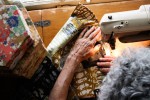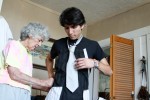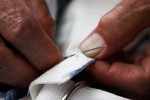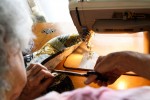Teaching and Learning and Caring Blog
EL PASO — I can’t thread a needle or put material in the sewing machine without thinking about Mrs. Lane. She was my home economics teacher at Cloudcroft High School fifty years ago and I was one of her problem students. I resented the whole purpose of the class, making good little wives of us. It was my job as class clown to ask whether a tablespoon of water needed to be heaping or level. Just yesterday I came across a recipe for a soufflé and scrunched up my face in the vivid memory of that sunken mess. Not much in the cooking department. Back to sewing.
Despite her best efforts, I never really learned. I spent more time making jokes and ripping out seams than sewing cloth together. It was a perceptual problem. I didn’t understand how measurements made in two dimensions could be sewn and become clothing that we wear in three. I had trouble measuring anyway. Zippers and sleeves were a special hell but French seams were the coolest ever. Every success was matched by a predictable glitch that surprised me nevertheless.

This exercise taught me that we can eventually figure things out if we keep trying. (Raymundo Aguirre/Borderzine.com)
I was determined. I didn’t like this class, but I did want to make something with my own hands. That summer I bought some fabric and the simplest of Simplicity patterns, an A-line dress which must have been in vogue in the early sixties because of Jackie Kennedy or other forces beyond my memory. This project was designed for trial and error, designed for me to figure out my own problems. There were many and it was weeks before I finished. I made the hem as short as I thought I could get away with. It was the sixties. After the requisite modeling for my mother, the dress was never worn; it was already worn…out.
This exercise taught me that we can eventually figure things out if we keep trying. But who wants to keep trying when you aren’t already good at something? It is easy to keep doing something when everyone around you praises you for it, and by continuing we also ensure that we don’t forget the lessons we have already learned once. But sewing showcases all my flaws and few of my talents. Sewing every now and again means I start from scratch every time, with my perceptual problems and measurement issues. Sewing is not kinesthetic knowledge, like riding a bicycle. I have to reach down deep inside myself for a heaping tablespoon of perseverance.
And there is something else about this home economics business, especially for women who grew up in the fifties and sixties, or especially academic women whose mothers were housewives, regardless of when they grew up. My class with Mrs. Lane was not optional. I also had to take typing in case I needed to become a secretary. The boys had to take shop and agriculture. I thought cooking and sewing were beneath me and didn’t mix well with more scholarly pursuits. Or maybe back then I thought furry animals and greasy cars would be more fun. Being a good little wife was not my ambition, but I don’t think I really meant to cut myself off from the richness of taste and color and texture on my tongue, on my skin. Or the simple joy that comes from doing something tangible and sharing it with others. Ideas are elusive; meals and aprons are not.
Malcolm Gladwell (in Outliers) suggests it takes about 10,000 hours to get really good at something. But who’s counting? Maybe I will even find a soufflé recipe that appeals to me.
- Sewing by hand so things don’t get out of control. (Raymundo Aguirre/Borderzine.com)
- Sewing is hard; try again. (Raymundo Aguirre/Borderzine.com)
- Cooking is easy: rellenos and garden veggies. (Raymundo Aguirre/Borderzine.com)
- Cheryl fitting an “executive” apron on Raymundo. (Photo courtesy of Josie Jimarez-Howard)
- This exercise taught me that we can eventually figure things out if we keep trying. (Raymundo Aguirre/Borderzine.com)
- Raymundo’s lunch! (Raymundo Aguirre/Borderzine.com)
- The closet with a window where the sewing machine resides. (Raymundo Aguirre/Borderzine.com)








